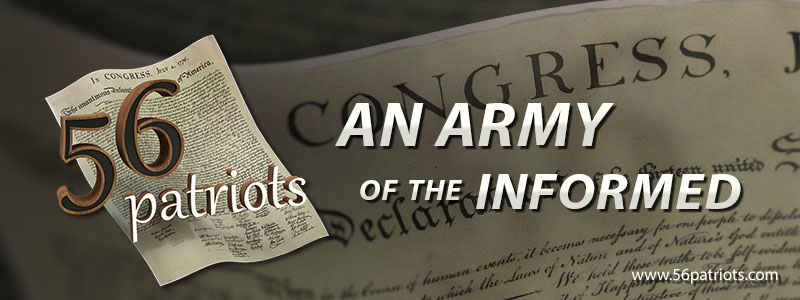The Shell Game of Corrupted Government Exposed
Why Can't Women Be Both Pro-Choice AND Pro-Life? It's Possible With Common-Sense Limitations on Abortions
Questions: "So the case eventually made it to the Supreme Court. How did the Court rule?"
Mr. Clarke: "The Justices declared the Texas and Georgia laws unconstitutional and then rewrote a national law, a national abortion law, in which they said that the states could not regulate or limit abortion in the first trimester. They could regulate more in the second trimester, the second three months of pregnancy, to protect maternal health and they could regulate in the last three months of pregnancy, the last trimester, to protect maternal health or fetal life. The attorneys for the plaintiffs claimed that abortion fell within the right to privacy, even though privacy is not in the text of the Constitution, they said it was derived, or based in the language of the 14th Amendment of the Constitution even though the 14th Amendment doesn't say anything about abortion, or the unborn child; the 14th Amendment just uses the term liberty. Ultimately the Court said that the right to abortion is part of the right to privacy based on the 14th Amendment."
Question: "That's very interesting. I've learned through many of these interviews, that this right to privacy is something that is never actually explicitly stated throughout the Bill of Rights, but there's a penumbra of privacy that you see in a few ways. What was the Court's reasoning that the right to an abortion could fall under this zone of privacy?"
Mr. Clarke: "If you read the Roe opinion - specifically, on page 152 of the Roe opinion - Justice Blackmun starts out by citing a string of prior Supreme Court cases, beginning about 1910, which elude to a right of privacy which undergirds other rights in the Bill of Rights. Blackmun argued that these cases lead to a general right of privacy, and that this right of privacy is broad enough to encompass a woman's right to an abortion. But then four pages later, on page 156, Blackmun turns around and says that abortion is inherently different from all those other cases that make up the right of privacy (including the right to use contraception and contraceptive devices to control fertility and reproduction, Griswold v. Connecticut (1965) because it involves the taking of a life."
Ms. Murray: "The right of privacy doesn't actually come from Roe vs. Wade. It comes from a case decided about eight years earlier, in 1965, called Griswold vs. Connecticut. The issue in the Griswold case was whether a Connecticut state statute that made it a crime to use contraception or even to counsel patients about contraception violated the Constitution. Planned Parenthood League of Connecticut opened up a birth control clinic in New Haven, Connecticut. They were promptly arrested and the clinic was closed. They challenged the statute, arguing that the right to use contraception was a fundamental individual right. Furthermore, they argued that since individuals have the right to use contraception, doctors also have the right to advise patients about such. Patients are entitled to be informed about their medical choices. The Supreme Court, in an opinion authored by Justice William Douglas, agreed with the clinic. In the Griswold case, the Court articulated for the first time this right of privacy. The opinion explained that while the Constitution does not explicitly protect a general right to privacy, the various guarantees within the Bill of Rights create penumbras, or zones, that establish a right to privacy. Together, the First (the right to conscience created by the right to worship freely), the Third (the right to be free in one's home from the quartering of troops), the Fourth (the right to be safe and secure in one's own person, one's home, and with one's effects from unreasonable government searches and seizures), and the Ninth Amendments create the right to privacy which encompasses marital relations. Douglas, writing for the majority, indicated that this right had actually 'been percolating in the Court's decisions for some time.'"
Question: "Did any of the Justices dissent in the Roe decision and if so, why?"
Mr. Clarke: "Well there were two dissents, one by Justice White and the other by Justice Rehnquist. Justice White said that the Court was engaging in raw judicial power (ie, judicial activism) and that the Justices did not have the right or the authority, on account of the 10th Amendment, to strike down the abortion laws of the individual states: it could only rely on a doctrine called 'substantive due process.' The justices were addressing the assertion that a woman's right to an abortion is a fundamental right and hence, under the Due Process Clause of the 14th Amendment, it cannot be violated or burdened. The Due Process Clause says that no person can be deprived of "life, liberty, or property, without due process of law." However, there are clear limits as to which individual "liberty" rights are imposed on a state (that is, those which it is obligated to respect and refrain from regulating). In in 1934, the Supreme Court held that due process is violated "if a practice or rule offends some principle of justice so rooted in the traditions and conscience of our people as to be ranked as fundamental." In other words, as explained further by the Court, the right must have been recognized as a liberty right (essential to our sense of ordered liberty) at the time of the adoption of the 14th Amendment to be recognized by its Due Process Clause. Justice Rehnquist said that there is clear historical evidence that many states passed abortion limits and prohibitions precisely at the time of the framing of the 14th Amendment in the 1860s and leading up to 1868, which is when the Amendment was added to the Constitution. In other words, this history was evidentiary history. As such, this history of state limits and prohibitions on abortion actually served to contradict the petitioner's (the birth control clinic's) assertion that the 14th Amendment was intended to include a right to abortion."
Question: "It appears that Roe is not the last word on abortion in the United States. There have been several later cases that were important to this as well, like Planned Parenthood vs. Casey, or Whole Woman's Health vs. Hellerstedt. Can you talk a little bit about how those cases have altered the scope of the right to abortion?
Ms. Murray: "As soon as Roe was decided in 1973, there was an effort to sort of roll it back and hem it in a little bit. Frank Church, who's a Senator from Idaho, announced 'The Church Amendment,' which basically says that physicians don't have to perform abortions if doing so would conflict with their conscience or conscientious beliefs. So we see one way to limit the reach of this right - by limiting the number of providers who are available to offer abortions."
Mr. Clarke: "In fact, the Court has kind of cut back on Roe vs. Wade in four cases over the years. But then in 2016, it appeared to return to its original position that the state nor federal government would tolerate any impermissible burden to a woman's right to an abortion:
Harris vs. McRae [A 1980 case in which the Court acknowledged that federal funding could be limited for abortions. The Court held that states participating in the Medicaid program (established under Title XIX of the Social Security Act) were not obligated to fund medically necessary abortions. Title XIX of the Social Security Act was enacted to provide federal financial assistance to states that chose to reimburse certain costs of medical treatment for needy persons. Beginning in 1976, Congress passed a number of versions of what was known as the "Hyde Amendment" which severely limited the use of federal funds to reimburse the cost of abortions under the Medicaid program. Cora McRae, a pregnant Medicaid recipient, challenged the Hyde Amendment, filing suit against Patricia R. Harris, the US Secretary of Health and Human Services. The Supreme Court found that a woman's freedom of choice did not carry with it "a constitutional entitlement to the financial resources to avail herself of the full range of protected choices"].
Planned Parenthood vs. Casey [A 1992 case in which the Supreme Court upheld various restrictions to an immediate abortion (an "abortion on demand"). The Pennsylvania state legislature amended its abortion control law in 1988 and 1989, to required informed consent and a 24 hour waiting period prior to the procedure. A minor seeking an abortion required the consent of one parent (the law allows for a judicial bypass procedure). A married woman seeking an abortion had to indicate that she notified her husband of her intention to abort the fetus. These provisions were challenged by several abortion clinics and physicians. In a bitter, 5-to-4 decision, the Supreme Court again re-affirmed Roe, but it upheld most of the Pennsylvania provisions. For the first time, the Court imposed an articulable standard to determine the validity of laws restricting abortions. The standard asks whether a state abortion regulation has the purpose or effect of imposing an "undue burden" on a woman's right to an abortion, which is defined as a "substantial obstacle in the path of a woman seeking an abortion before the fetus attains viability." Under this standard, the only provision to fail the undue-burden test was the husband notification requirement]. Other similar cases involving restrictions on immediate access to an abortion reached the same conclusion.
Whole Woman's Health versus Hellerstedt [In 2016, the Supreme Court flipped. In this case, the Supreme Court was asked to rule on the constitutionality of a Texas law that put limits on physicians performing abortions and on the abortion facilities themselves. A group of abortion providers sued the state. In a 5-3 opinion authored by Justice Stephen Breyer (remember, Justice Scalia had passed in February or 2016 and so it was only an 8-member Court at the time) the Supreme Court noted that the provisions that were challenged did not actually offer the medical benefits that they claimed to offer. Hence, as a matter of constitutionality, they were insufficient to justify the burdens on access that each of those provisions imposed.
Question: "What do you see as the future of Roe vs. Wade?"
Mr. Clarke: "Well, the Supreme Court has failed as the national abortion control board. It cannot monitor abortion. It can't intervene, it can't regulate or legislate itself, it can't act as public health administrators, and it can't investigate. And so I believe it's absolutely certain that the Court, sooner or later, will have to overturn the Roe decision because of this failure and return the matter to the states."
Ms. Murray: "Remember, when they were talking about repealing or reforming those abortion laws we referred to earlier, from the 1960s and 70s, it was connected in a big way to the growing women's rights social movement. Perhaps the most critical question of that movement asked 'What will be the role of women going forth in a modern society.' When the question of contraception came before the Court in 1965, one of the questions was whether women should be allowed to control her reproduction and to choose when to have children.... Should she be allowed to control the timing of births in order to accommodate her career. It's the same issue that came up in the abortion debate. If women were to have equal opportunities in the workforce, they would need to determine when they would become mothers and to determine the timing of their children. They would also need the flexibility to determine if they even wanted a child in the first place."
Question: "So we've learned that the decision to legalize abortion in Roe vs. Wade was based on the right of privacy, which the Supreme Court has inferred from the Due Process Clause of the 14th Amendment. Since the Roe decision, a number of other cases have set limits on abortion and abortion clinics. Clarke Forsythe argues that the Supreme Court has failed in regulating abortion and that the issue should be returned to the states. Melissa Murray, by contrast, suggests that the decision in Roe is crucial to giving women the freedom to join the workforce and make decisions about when to have children.
To learn more about his case, visit the National Constitution Center's Interactive Constitution and Khan Academy's resources on US Government and Politics.
Go Back
Mr. Clarke: "The Justices declared the Texas and Georgia laws unconstitutional and then rewrote a national law, a national abortion law, in which they said that the states could not regulate or limit abortion in the first trimester. They could regulate more in the second trimester, the second three months of pregnancy, to protect maternal health and they could regulate in the last three months of pregnancy, the last trimester, to protect maternal health or fetal life. The attorneys for the plaintiffs claimed that abortion fell within the right to privacy, even though privacy is not in the text of the Constitution, they said it was derived, or based in the language of the 14th Amendment of the Constitution even though the 14th Amendment doesn't say anything about abortion, or the unborn child; the 14th Amendment just uses the term liberty. Ultimately the Court said that the right to abortion is part of the right to privacy based on the 14th Amendment."
Question: "That's very interesting. I've learned through many of these interviews, that this right to privacy is something that is never actually explicitly stated throughout the Bill of Rights, but there's a penumbra of privacy that you see in a few ways. What was the Court's reasoning that the right to an abortion could fall under this zone of privacy?"
Mr. Clarke: "If you read the Roe opinion - specifically, on page 152 of the Roe opinion - Justice Blackmun starts out by citing a string of prior Supreme Court cases, beginning about 1910, which elude to a right of privacy which undergirds other rights in the Bill of Rights. Blackmun argued that these cases lead to a general right of privacy, and that this right of privacy is broad enough to encompass a woman's right to an abortion. But then four pages later, on page 156, Blackmun turns around and says that abortion is inherently different from all those other cases that make up the right of privacy (including the right to use contraception and contraceptive devices to control fertility and reproduction, Griswold v. Connecticut (1965) because it involves the taking of a life."
Ms. Murray: "The right of privacy doesn't actually come from Roe vs. Wade. It comes from a case decided about eight years earlier, in 1965, called Griswold vs. Connecticut. The issue in the Griswold case was whether a Connecticut state statute that made it a crime to use contraception or even to counsel patients about contraception violated the Constitution. Planned Parenthood League of Connecticut opened up a birth control clinic in New Haven, Connecticut. They were promptly arrested and the clinic was closed. They challenged the statute, arguing that the right to use contraception was a fundamental individual right. Furthermore, they argued that since individuals have the right to use contraception, doctors also have the right to advise patients about such. Patients are entitled to be informed about their medical choices. The Supreme Court, in an opinion authored by Justice William Douglas, agreed with the clinic. In the Griswold case, the Court articulated for the first time this right of privacy. The opinion explained that while the Constitution does not explicitly protect a general right to privacy, the various guarantees within the Bill of Rights create penumbras, or zones, that establish a right to privacy. Together, the First (the right to conscience created by the right to worship freely), the Third (the right to be free in one's home from the quartering of troops), the Fourth (the right to be safe and secure in one's own person, one's home, and with one's effects from unreasonable government searches and seizures), and the Ninth Amendments create the right to privacy which encompasses marital relations. Douglas, writing for the majority, indicated that this right had actually 'been percolating in the Court's decisions for some time.'"
Question: "Did any of the Justices dissent in the Roe decision and if so, why?"
Mr. Clarke: "Well there were two dissents, one by Justice White and the other by Justice Rehnquist. Justice White said that the Court was engaging in raw judicial power (ie, judicial activism) and that the Justices did not have the right or the authority, on account of the 10th Amendment, to strike down the abortion laws of the individual states: it could only rely on a doctrine called 'substantive due process.' The justices were addressing the assertion that a woman's right to an abortion is a fundamental right and hence, under the Due Process Clause of the 14th Amendment, it cannot be violated or burdened. The Due Process Clause says that no person can be deprived of "life, liberty, or property, without due process of law." However, there are clear limits as to which individual "liberty" rights are imposed on a state (that is, those which it is obligated to respect and refrain from regulating). In in 1934, the Supreme Court held that due process is violated "if a practice or rule offends some principle of justice so rooted in the traditions and conscience of our people as to be ranked as fundamental." In other words, as explained further by the Court, the right must have been recognized as a liberty right (essential to our sense of ordered liberty) at the time of the adoption of the 14th Amendment to be recognized by its Due Process Clause. Justice Rehnquist said that there is clear historical evidence that many states passed abortion limits and prohibitions precisely at the time of the framing of the 14th Amendment in the 1860s and leading up to 1868, which is when the Amendment was added to the Constitution. In other words, this history was evidentiary history. As such, this history of state limits and prohibitions on abortion actually served to contradict the petitioner's (the birth control clinic's) assertion that the 14th Amendment was intended to include a right to abortion."
Question: "It appears that Roe is not the last word on abortion in the United States. There have been several later cases that were important to this as well, like Planned Parenthood vs. Casey, or Whole Woman's Health vs. Hellerstedt. Can you talk a little bit about how those cases have altered the scope of the right to abortion?
Ms. Murray: "As soon as Roe was decided in 1973, there was an effort to sort of roll it back and hem it in a little bit. Frank Church, who's a Senator from Idaho, announced 'The Church Amendment,' which basically says that physicians don't have to perform abortions if doing so would conflict with their conscience or conscientious beliefs. So we see one way to limit the reach of this right - by limiting the number of providers who are available to offer abortions."
Mr. Clarke: "In fact, the Court has kind of cut back on Roe vs. Wade in four cases over the years. But then in 2016, it appeared to return to its original position that the state nor federal government would tolerate any impermissible burden to a woman's right to an abortion:
Harris vs. McRae [A 1980 case in which the Court acknowledged that federal funding could be limited for abortions. The Court held that states participating in the Medicaid program (established under Title XIX of the Social Security Act) were not obligated to fund medically necessary abortions. Title XIX of the Social Security Act was enacted to provide federal financial assistance to states that chose to reimburse certain costs of medical treatment for needy persons. Beginning in 1976, Congress passed a number of versions of what was known as the "Hyde Amendment" which severely limited the use of federal funds to reimburse the cost of abortions under the Medicaid program. Cora McRae, a pregnant Medicaid recipient, challenged the Hyde Amendment, filing suit against Patricia R. Harris, the US Secretary of Health and Human Services. The Supreme Court found that a woman's freedom of choice did not carry with it "a constitutional entitlement to the financial resources to avail herself of the full range of protected choices"].
Planned Parenthood vs. Casey [A 1992 case in which the Supreme Court upheld various restrictions to an immediate abortion (an "abortion on demand"). The Pennsylvania state legislature amended its abortion control law in 1988 and 1989, to required informed consent and a 24 hour waiting period prior to the procedure. A minor seeking an abortion required the consent of one parent (the law allows for a judicial bypass procedure). A married woman seeking an abortion had to indicate that she notified her husband of her intention to abort the fetus. These provisions were challenged by several abortion clinics and physicians. In a bitter, 5-to-4 decision, the Supreme Court again re-affirmed Roe, but it upheld most of the Pennsylvania provisions. For the first time, the Court imposed an articulable standard to determine the validity of laws restricting abortions. The standard asks whether a state abortion regulation has the purpose or effect of imposing an "undue burden" on a woman's right to an abortion, which is defined as a "substantial obstacle in the path of a woman seeking an abortion before the fetus attains viability." Under this standard, the only provision to fail the undue-burden test was the husband notification requirement]. Other similar cases involving restrictions on immediate access to an abortion reached the same conclusion.
Whole Woman's Health versus Hellerstedt [In 2016, the Supreme Court flipped. In this case, the Supreme Court was asked to rule on the constitutionality of a Texas law that put limits on physicians performing abortions and on the abortion facilities themselves. A group of abortion providers sued the state. In a 5-3 opinion authored by Justice Stephen Breyer (remember, Justice Scalia had passed in February or 2016 and so it was only an 8-member Court at the time) the Supreme Court noted that the provisions that were challenged did not actually offer the medical benefits that they claimed to offer. Hence, as a matter of constitutionality, they were insufficient to justify the burdens on access that each of those provisions imposed.
Question: "What do you see as the future of Roe vs. Wade?"
Mr. Clarke: "Well, the Supreme Court has failed as the national abortion control board. It cannot monitor abortion. It can't intervene, it can't regulate or legislate itself, it can't act as public health administrators, and it can't investigate. And so I believe it's absolutely certain that the Court, sooner or later, will have to overturn the Roe decision because of this failure and return the matter to the states."
Ms. Murray: "Remember, when they were talking about repealing or reforming those abortion laws we referred to earlier, from the 1960s and 70s, it was connected in a big way to the growing women's rights social movement. Perhaps the most critical question of that movement asked 'What will be the role of women going forth in a modern society.' When the question of contraception came before the Court in 1965, one of the questions was whether women should be allowed to control her reproduction and to choose when to have children.... Should she be allowed to control the timing of births in order to accommodate her career. It's the same issue that came up in the abortion debate. If women were to have equal opportunities in the workforce, they would need to determine when they would become mothers and to determine the timing of their children. They would also need the flexibility to determine if they even wanted a child in the first place."
Question: "So we've learned that the decision to legalize abortion in Roe vs. Wade was based on the right of privacy, which the Supreme Court has inferred from the Due Process Clause of the 14th Amendment. Since the Roe decision, a number of other cases have set limits on abortion and abortion clinics. Clarke Forsythe argues that the Supreme Court has failed in regulating abortion and that the issue should be returned to the states. Melissa Murray, by contrast, suggests that the decision in Roe is crucial to giving women the freedom to join the workforce and make decisions about when to have children.
To learn more about his case, visit the National Constitution Center's Interactive Constitution and Khan Academy's resources on US Government and Politics.
| 9th District hearing set for Feb. 18 | Local News & Expression, Editorials, For Love of God and Country, Op-Ed & Politics | Governor Cooper Urges Resolution of ECU/Virginia Tech Football Series Dispute |























